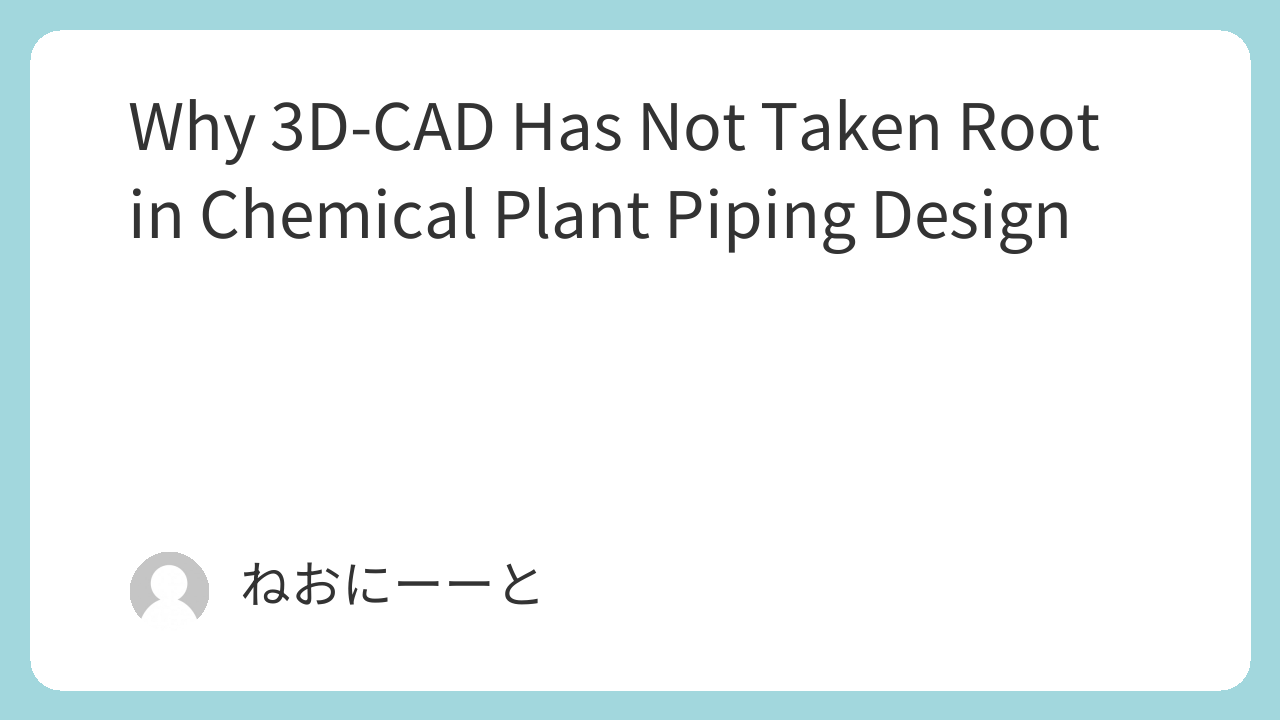Is 3D-CAD becoming the norm in piping design for chemical plants?
In recent years, 3D-CAD has become standard in many engineering fields. However, in the context of chemical plant piping design, opportunities to use 3D-CAD remain limited. Although it has been a topic of discussion for more than 10 years, the transition from 2D to 3D has not been widely realized. This article revisits the challenges, both old and new, from the perspective of an owner’s engineer.
Issues Already Identified in the Past
Need for Skills
The shortage of engineers capable of handling 3D-CAD remains a critical issue. This is not primarily a challenge for engineering contractors, but rather for owner’s engineers.
Owner’s engineers usually manage piping design in-house or through small outsourced teams, often consisting of only a few people. For engineers who have worked solely in 2D for years, switching to 3D requires a strong incentive, which is often absent. Because 3D-CAD requires specific skills, this continues to be a barrier.
Environment Setup
I personally do not consider system setup for 3D-CAD to be a significant barrier. After all, similar challenges exist with 2D-CAD.
On-Site Verification
Bringing 3D-CAD drawings into the field during construction or modification work is difficult. Companies that often deal with retrofits and expansions in existing plants find it especially hard to apply 3D-CAD effectively. By contrast, printed 2D drawings are much simpler to use on site.
Additional Challenges for Owner’s Engineers
No System to Reflect Daily Modifications
Perhaps the greatest reason why 3D-CAD has not spread among owner’s engineers is the inability to keep up with daily repair and modification work.
Although 3D-CAD models are visually appealing and useful for estimation, they quickly become outdated as soon as emergency field repairs occur.
In practice, piping often requires temporary fixes during nighttime operations or unexpected breakdowns. Expecting operators to report every such change to the design team for model updates is unrealistic. For the operator, this reporting is a burden that delays the resolution of urgent issues. For designers, on the other hand, the lack of accurate field feedback makes maintaining the 3D model impossible.
Thus, the theoretical benefits of digitizing piping information in 3D-CAD only materialize if there is a dedicated system and personnel for continuous updates — a very high hurdle.
Application to Existing Plants
Using 3D-CAD is possible for new plant construction where sufficient resources can be allocated. The real challenge lies in existing plants. Converting them into 3D models requires significant additional investment.
Switching entirely from 2D to 3D is a tough decision. Many companies end up splitting — keeping existing facilities in 2D and only applying 3D to new projects. This increases overall CAD costs.
Excessive Focus on Visualization
Another perceived advantage of 3D-CAD is improved visualization for non-design staff. Few managers can mentally translate a 2D drawing into a real-world image, and dissatisfaction often emerges after construction. However, in reality, many of these issues are minor and rarely justify costly redesigns.
Decline in Plant Construction Demand
Even if 3D-CAD is positioned as a tool for new plant construction, opportunities for large-scale projects are decreasing. This further weakens the incentive to adopt 3D-CAD widely.
Challenges for Engineering Contractors
Engineering companies also face difficulties:
- They cannot fully understand or adapt to the diverse needs of different plant operators.
- They prefer standardizing on 3D-CAD because it reduces the need to maintain 2D expertise.
- Their focus is on delivering plants, not supporting the owner’s daily maintenance needs.
This misalignment between owner’s engineers and engineering contractors further slows down the spread of 3D-CAD.
Conclusion
3D-CAD has undeniable strengths in visualization, planning, and cost estimation. However, the practical hurdles for chemical plants — skill shortages, maintenance requirements, and retrofitting complexities — prevent its widespread use. For owner’s engineers, the key is to identify the limited situations where 3D-CAD truly adds value, rather than expecting it to replace 2D entirely.

Comments